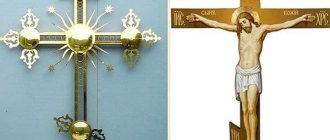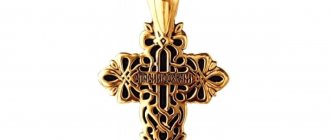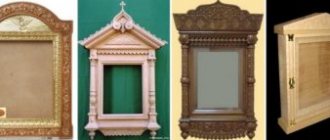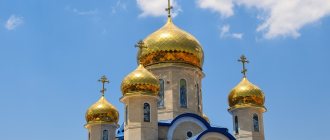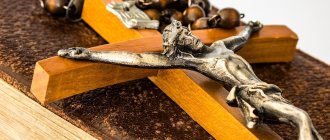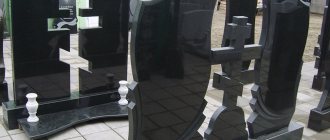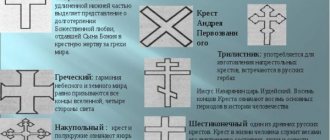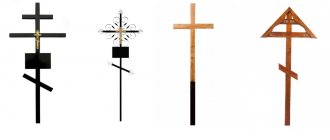Audio version of the article
- History of the Holy Cross K. Parkhomenko
- About the sign of the cross and pectoral crosses Answers to questions
- Holy cross K. Slepinin
- Is it possible to remove a pectoral cross? Deacon Sergius Shalberov
- Truth and myths about the pectoral cross of Rev. Nikolay Markovsky
- Breviary. The rite of blessing the cross to be worn on the chest
- Photo story “Pectoral Cross”
***
A pectoral cross is a small cross that symbolically displays the Cross on which the Lord Jesus Christ was crucified (sometimes with the image of the Crucified One, sometimes without such an image), intended to be constantly worn by an Orthodox Christian as a sign of his faith and fidelity to Christ, belonging to the Orthodox Church, serving as a means for grace-filled protection.
The cross is the greatest Christian shrine, a visible evidence of our redemption. In the service for the Feast of the Exaltation, the Church glorifies the tree of the Cross of the Lord with many praises: “The Cross is the guardian of the entire universe, the beauty of the Church, the power of kings, the affirmation of the faithful, the glory of angels and the plague of demons.”
A pectoral cross is given to a baptized person who becomes a Christian and is constantly worn in the most important place (near the heart) as an image of the Cross of the Lord, an external sign of an Orthodox Christian. This is also done as a reminder that the Cross of Christ is a weapon against fallen spirits, having the power to heal and give life. That is why the Cross of the Lord is called Life-Giving!
He is evidence that a person is a Christian (a follower of Christ and a member of His Church). This is why it is a sin for those who wear a cross for fashion without being a member of the Church. Consciously wearing a cross on the body is a wordless prayer, allowing this cross to demonstrate the true power of the Archetype - the Cross of Christ, which always protects the wearer, even if he does not ask for help, or does not have the opportunity to cross himself.
When performing the sacrament of Baptism, the priest puts a cross on the baby, which from that moment becomes the inseparable companion of the new member of the Church. It is not customary to remove a cross when bathing or changing clothes (in the old days there were even wooden crosses in the baths, which were worn in the steam room instead of their own). Unfortunately, there are also “knowledgeable” advisers: nurses, neighbors, friends who authoritatively convince the mother to remove the cross from the child: they say he is still small, he will get tangled in the ribbon, he will chafe the skin, etc.
There are canonical forms of crosses - four-, six-, eight-pointed; with a semicircle below and others. Each line has a deep symbolic meaning. In Rus', eight-pointed crosses are more common, on the back of which, according to tradition, the inscription “Save and Preserve” is written. Saint Demetrius of Rostov wrote back in the 18th century: “We reverence the Cross of Christ not by the number of trees, not by the number of ends, but by Christ himself, whose Most Holy Blood was stained with Him. Displaying miraculous power, any Cross does not act by itself, but by the power of Christ crucified on it and by invoking His Most Holy Name.”
There are no rules about the material for crosses. Obviously, precious metals are also acceptable here, because for a Christian nothing can be more valuable than a cross - hence the desire to decorate it. But, of course, simple wooden or metal crosses are closer in spirit to the Cross of the Lord. There is also no fundamental difference between a chain and a braid: it is important that the cross is held firmly. The cross should not be removed, incl. during washing and sports activities. Lay people wear a cross (on the body) under their clothes, without deliberately showing it off.
In the first centuries of Russia’s adoption of Christianity, crosses were worn not on the body, but on top of clothing “as clear indicators of Christian baptism.” Later, only bishops had the right to wear a cross over their clothes until the 18th century, and even later – priests. The priestly pectoral cross is called a pectoral cross (“persi” in Church Slavonic means “chest”). Along with the pectoral, priests also wear a pectoral cross.
Russian people swore allegiance on crosses, and by exchanging pectoral crosses, they became cross brothers. When building churches, houses, and bridges, a cross was laid in the foundation. There was a custom to cast many crosses from a broken church bell, which were especially revered. Taking off one's cross or not wearing it has always been understood as apostasy. Over the 2000-year history of Christianity, many people have suffered for their faith, for refusing to renounce Christ and take off their pectoral cross. This feat has been repeated in our time.
There are many superstitions associated with the pectoral cross : if you lose the cross, disaster will happen; a cross lost by someone cannot be picked up; a cross cannot be given as a gift, worn on a chain, and the like. All of them have no basis: you can buy a new cross, wear one that was given or found, and consecrate it in the temple. Those crosses that are sold in the temple are consecrated with a special rite.
***
How to choose a pectoral cross?
A pectoral cross is not a piece of jewelry. No matter how beautiful it may be, no matter what precious metal it is made of, it is first and foremost a visible symbol of the Christian faith.
Orthodox pectoral crosses have a very ancient tradition and therefore are very diverse in appearance, depending on the time and place of manufacture. The traditional Orthodox pectoral cross has an eight-pointed shape.
The veneration of the cross and love for it is manifested in the richness and variety of its decorations. Pectoral crosses have always been distinguished by their diversity both in the choice of material from which they were made - gold, silver, copper, bronze, wood, bone, amber - and in their shape. And therefore, when choosing a cross, you need to pay attention not to the metal from which the cross is made, but to whether the shape of the cross corresponds to Orthodox traditions, which will be discussed below.
Story
The cross has long indicated that its bearer belongs to Christians. The cross is revered by believers, because on it the Savior accepted martyrdom to atone for the sins of all mankind. This method of execution was popular in the Roman Empire of that time; previously such execution was considered shameful. After the suffering of Christ, the cross became a sign of victory and a reminder of the Savior’s endless love for people.
Important! The cross was sanctified by the blood of the Son of God. With his suffering, Christ closed the debt of humanity to the Almighty, voluntarily taking the guilt of all people onto his shoulders.
In Rus', the tradition of wearing a breast cross arose after Prince Vladimir recognized Christianity as the official religion of the Russian state. Many pagans did not want to be baptized and hid their religious beliefs.
The cross as a symbol is used in many religions
Then it was decided to give all those who were actually baptized small crosses, which they should always carry with them. This was the only way to distinguish a pagan from a Christian.
Important! Since then, only a baptized person has the right to wear a cross.
Is it possible to wear crosses with a Catholic Crucifix?
The iconography of the Orthodox Crucifixion received its final dogmatic justification in 692 in the 82nd rule of the Trull Cathedral, which approved the canon of the iconographic image of the Crucifixion. The main condition of the canon is the combination of historical realism with the realism of Divine Revelation. The figure of the Savior expresses Divine peace and greatness. It is as if it were placed on a cross and the Lord opens His arms to everyone who turns to Him.
In this iconography, the complex dogmatic task of depicting the two natures of Christ - Human and Divine - is artistically solved, showing both the death and the victory of the Savior. Catholics, having abandoned their early views, did not understand and did not accept the rules of the Council of Trull and, accordingly, the symbolic spiritual image of Jesus Christ.
Thus, in the Middle Ages, a new type of Crucifixion emerged, in which the naturalistic features of human suffering and the agony of execution on the cross became predominant: the weight of the body sagging on outstretched arms, the head crowned with a crown of thorns, the crossed feet nailed with one nail (an innovation at the end of the 13th century). The anatomical details of the Catholic depiction, while conveying the veracity of the execution itself, nevertheless hide the main thing - the triumph of the Lord, who defeated death and reveals to us eternal life, and concentrates attention on torment and death. His naturalism has only an external emotional impact, leading to the temptation of comparing our sinful sufferings with the redemptive Passion of Christ. Images of the crucified Savior, similar to Catholic ones, are also found on Orthodox crosses, especially often in the 18th–20th centuries, however, as well as iconographic images of God the Father prohibited by the Stoglavy Cathedral. Naturally, Orthodox piety requires the wearing of an Orthodox cross, and not a Catholic one, which violates the dogmatic foundations of the Christian faith.
What does the cross mean in Catholicism and Orthodoxy?
On the Russian, or St. Lazarus Cross, as it is also called, the lower crossbar is tilted to the right. This is explained by the fact that one of the criminals crucified next to Jesus mocked Christ and demanded that all three condemned to execution be miraculously released, and the second, before his death, said, “He was falsely condemned.” Jesus promised the one who believed a place in heaven, but the one who blasphemed pulled the crossbar into the abyss of hell with his slander. The balancing bar symbolizes the throwing of the human soul. Thus, the eight-pointed cross symbolically depicts the foundations of Christian doctrine. The Catholic crucifixion depicts the suffering of Christ on the cross, emphasizing his bodily suffering, while Orthodoxy emphasizes the method of execution - only crucifixion could make it possible for Him to die with His arms outstretched in all directions, thus the recognition of universal redemption becomes paramount.
Thus, Catholics pay special attention to the Passion of Christ (the events of the last week of his earthly life), and Orthodox Christians see the Triumph of the Holy Spirit in humiliating death: through suffering comes the redemption of sin. No wonder there is an expression in the Russian language: “Everyone has his own cross.”
How to consecrate a pectoral cross?
Traditionally, in the Orthodox Church, the consecration of the pectoral cross is performed by a clergyman in the church. The rite of blessing the cross to be worn on the forehead, i.e. on the chest, contained in the liturgical book - Trebnik.
The cross is consecrated only once. It needs to be reconsecrated only in exceptional conditions (if it was severely damaged and restored again, or fell into your hands, but you do not know whether it was consecrated before).
There is a superstition that when consecrated, the cross acquires magical protective properties. The Church teaches that the sanctification of matter allows us not only spiritually, but also physically - through this sanctified matter - to join the Divine grace that we need for spiritual growth and salvation. But the grace of God does not act unconditionally. A person is required to have a correct spiritual life according to God’s commandments, and it is this spiritual life that makes it possible for God’s grace to have a salutary effect on us, healing us from passions and sins.
Sometimes you hear the opinion that the consecration of crosses is a late tradition and that this has never happened before. To this we can answer that the Gospel, as a book, also once did not exist and there was no Liturgy in its current form. But this does not mean at all that the Church cannot develop forms of worship and church piety. Is it contrary to Christian doctrine to invoke God’s grace on the creation of human hands?
Orthodox Life
Orthodoxy.Fm
Over the two thousand years of its existence, Christianity has spread across all continents of the Earth, among many peoples with their own cultural traditions and characteristics. It is therefore not surprising that one of the most recognizable symbols in the world, the Christian cross, has such a variety of shapes, sizes and uses.
In today's material we will try to talk about what types of crosses there are. In particular, you will find out: whether there are “Orthodox” and “Catholic” crosses, whether a Christian can treat a cross with contempt, whether crosses are in the shape of an anchor, why we also venerate a cross in the shape of the letter “X” and much more interesting things.
Cross in the church
First, let's remember why the cross is important to us. The veneration of the cross of the Lord is associated with the atoning sacrifice of the God-man Jesus Christ. By honoring the cross, an Orthodox Christian pays veneration to God Himself, who became incarnate and suffered on this ancient Roman instrument of execution for our sins. Without the cross and death there would be no redemption, resurrection and ascension, there would be no establishment of the Church in the world and no opportunity to follow the path of salvation for every person.
Since the cross is so revered by believers, they try to see it as often as possible in their lives. Most often, a cross can be seen in a temple: on its domes, on sacred utensils and vestments of clergy, on the chests of priests in the form of special pectoral crosses, in the architecture of the temple, which is often built in the shape of a cross.
Cross behind the church fence
In addition, it is common for a believer to expand his spiritual space to the entire life around him. A Christian sanctifies all its elements, first of all, with the sign of the cross.
Therefore, in cemeteries there are crosses over the graves, as a reminder of the future resurrection, on the roads there are worship crosses, sanctifying the path, on the bodies of Christians themselves there are crosses on the body, reminding a person of his high calling to follow the path of the Lord.
Also, the shape of a cross among Christians can often be seen in home iconostases, on rings and other household items.
Pectoral cross
The pectoral cross is a special story. It can be made from a wide variety of materials and have all kinds of sizes and decorations, retaining only its shape.
In Russia, they are accustomed to seeing a pectoral cross in the form of a separate object hanging on a chain or rope on the chest of a believer, but in other cultures there were other traditions. The cross could not be made of anything at all, but applied to the body in the form of a tattoo, so that a Christian could not accidentally lose it and so that it could not be taken away. This is exactly how the Celtic Christians wore the pectoral cross.
It is also interesting that sometimes the Savior is not depicted on the cross, but an icon of the Mother of God or one of the saints is placed on the field of the cross, or even the cross is turned into something like a miniature iconostasis.
About the “Orthodox” and “Catholic” crosses and contempt for the latter
In some modern popular science articles, one can find the statement that an eight-pointed cross with a short upper and oblique short lower additional crossbars is considered “Orthodox”, and a four-pointed cross elongated at the bottom is “Catholic” and the Orthodox supposedly belong or in the past belonged to it with contempt.
This is a statement that does not stand up to criticism. As you know, the Lord was crucified on a four-pointed cross, which, for the above reasons, was revered by the Church as a shrine long before the Catholics fell away from Christian unity, which occurred in the 11th century. How could Christians despise the symbol of their salvation?
In addition, at all times, four-pointed crosses were widely used in churches, and even now on the chests of Orthodox clergy one can find several possible forms of the cross - eight-pointed, four-pointed and figured with decorations. Would they really wear some kind of “non-Orthodox cross”? Of course not.
Eight-pointed cross
The eight-pointed cross is most often used in the Russian and Serbian Orthodox Churches. This form recalls some additional details of the Savior’s death.
An additional short upper crossbar denotes the titlo - the tablet on which Pilate inscribed the guilt of Christ: “Jesus of Nazareth - King of the Jews.” In some images of the crucifixion, the words are abbreviated to form "INCI" - in Russian or "INRI" - in Latin.
The short oblique lower crossbar, usually depicted with the right edge raised up and the left edge down (relative to the image of the crucified Lord), denotes the so-called “standard of righteousness” and reminds us of the two thieves crucified on the sides of Christ and their posthumous fate. The right one repented before death and inherited the Kingdom of Heaven, while the left one blasphemed the Savior and ended up in hell.
St. Andrew's cross
Christians venerate not only a straight cross, but also an oblique four-pointed cross, depicted in the form of the letter “X”. Tradition tells that it was on a cross of this shape that one of the twelve disciples of the Savior, the Apostle Andrew the First-Called, was crucified.
The “St. Andrew’s cross” is especially popular in Russia and the Black Sea countries, since it was around the Black Sea that the missionary path of the Apostle Andrew passed. In Russia, the St. Andrew's cross is depicted on the flag of the navy. In addition, the St. Andrew's cross is especially revered by the Scots, who also depicted it on their national flag and believe that the Apostle Andrew preached in their country.
T-cross
This cross was most common in Egypt and other provinces of the Roman Empire in North Africa. Crosses with a horizontal beam superimposed on a vertical post, or with a crossbar nailed just below the top edge of the post, were used to crucify criminals in these places.
Also, the “T-shaped cross” is called the “cross of St. Anthony” in honor of the Venerable Anthony the Great, who lived in the 4th century, one of the founders of monasticism in Egypt, who traveled with a cross of this shape.
Archbishop's and Papal crosses
In the Catholic Church, in addition to the traditional four-pointed cross, crosses with second and third crossbars above the main one are used, reflecting the hierarchical position of the bearer.
A cross with two bars signifies the rank of cardinal or archbishop. This cross is sometimes also called the “patriarchal” or “Lorraine”. The cross with three bars corresponds to papal dignity and emphasizes the high position of the Roman Pontiff in the Catholic Church.
Lalibela Cross
In Ethiopia, church symbolism uses a four-pointed cross surrounded by a complex pattern, which is called the “Lalibela cross” in honor of the holy Negus (king) of Ethiopia Gebre Meskel Lalibela, who ruled in the 11th century. Negus Lalibela was known for his deep and sincere faith, assistance to the Church and generous giving of alms.
Anchor cross
On the domes of some churches in Russia you can find a cross that stands on a crescent-shaped base. Some mistakenly explain such symbolism as wars in which Russia defeated the Ottoman Empire. Allegedly, “the Christian cross tramples the Muslim crescent.”
This shape is actually called the Anchor Cross. The fact is that already in the very first centuries of the existence of Christianity, when Islam had not even arisen, the Church was called the “ship of salvation”, which delivers a person to the safe haven of the Heavenly Kingdom. The cross was depicted as a reliable anchor on which this ship could wait out the storm of human passions. The image of a cross in the form of an anchor can be found in the ancient Roman catacombs where the first Christians hid.
Celtic cross
Before converting to Christianity, the Celts worshiped various elements, including the eternal luminary - the sun. According to legend, when Saint Patrick enlightened Ireland, he combined the symbol of the cross with the earlier pagan symbol of the sun to show the eternity and importance for each convert of the Savior's sacrifice.
Chrism - a hint of the cross
During the first three centuries, the cross, and especially the Crucifixion, were not depicted openly. The rulers of the Roman Empire began a hunt for Christians and they had to identify each other using not too obvious secret signs.
One of the hidden symbols of Christianity closest to the cross in meaning was “chrism” - a monogram of the name of the Savior, usually made up of the first two letters of the word “Christ”, “X” and “R”.
Sometimes symbols of eternity were added to the “chrism” - the letters “alpha” and “omega” or, as an option, it was made in the form of an St. Andrew’s cross crossed out by a transverse line, that is, in the form of the letters “I” and “X” and could be read as "Jesus Christ".
There are many other varieties of the Christian cross, which are widely used, for example, in the international award system or in heraldry - on the coats of arms and flags of cities and countries.
Andrey Szegeda
Orthodoxy.Fm
Is it possible to wear two crosses?
The main question is why, for what purpose? If you were given another one, then it is quite possible to reverently keep one of them in a holy corner next to the icons, and wear one constantly. If you bought another one, then wear it...
A Christian is buried with a pectoral cross, so it is not passed on by inheritance. As for wearing a second pectoral cross somehow left behind by a deceased relative, wearing it as a sign of memory of the deceased indicates a misunderstanding of the essence of wearing a cross, which testifies to the Sacrifice of God, and not family relationships.
A pectoral cross is not an ornament or an amulet, but one of the visible evidence of belonging to the Church of Christ, a means of grace-filled protection and a reminder of the Savior’s commandment: If anyone wants to come after Me, deny himself, and take up your cross, and follow Me... (Matthew .16:24).
***
In Rus' they said about an immoral person: “There is no cross on him.”
Difference between Orthodox and Catholic crucifixes
In addition to the difference in the shape of the cross between Eastern and Western Christians, there are also differences in the crucifix itself. Knowing the important distinctive features of Orthodox and Catholic crucifixes, you can easily determine which direction of Christianity this symbol belongs to.
Differences between Orthodox and Catholic crucifixes:
- Number of nails visible in a crucifix
- Position of Christ's body
If in the Orthodox tradition four nails are depicted on the crucifix - for each hand and leg separately, then in the Catholic tradition the legs of Christ are crossed and nailed with one nail, respectively, there are three nails on the crucifix.
Orthodoxy explains the presence of four nails by the fact that the cross on which Christ was crucified, brought by Queen Helena from Jerusalem to Constantinople, had traces of four nails.
Catholics justify their version of the three nails by the fact that all the nails of the cross on which Christ was crucified are kept in the Vatican, and there are only three of them. In addition, the image on the Shroud of Turin is printed in such a way that the legs of the crucified man are crossed, therefore it can be assumed that Christ’s legs were nailed with one nail.
The position of the body of Christ on the Orthodox crucifix is a little unnatural; the body of Jesus does not hang on his hands, as it should have happened according to physical laws. On the Orthodox crucifix, Christ’s hands extend along the cross to the sides, as if calling “all the ends of the earth” (Is. 45:22). The crucifix does not attempt to reflect pain, it is more symbolic. Orthodoxy explains such features of the crucifixion by the fact that the cross is, first of all, a weapon of victory over death. The crucifix in Orthodoxy is a symbol of the victory of life over death, and, paradoxically, almost an object of joy, because it contains the idea of the Resurrection.
On a Catholic crucifix, the position of the body is as close as possible to physiological: the body sags in the arms by its own weight. The Catholic crucifixion is more realistic: often depicted bleeding blood, stigmata from nails, spears.
Symbolic inscriptions on the monastic cross
Those who see the monastic eight-pointed Orthodox cross for the first time often have questions related to the inscriptions inscribed on it. Specifically, these are the IC and XC at the ends of the middle bar. These letters stand for nothing more than the abbreviated name – Jesus Christ. In addition, the image of the cross is accompanied by two inscriptions located under the middle crossbar - the Slavic inscription of the words “Son of God” and the Greek NIKA, which means “winner”.
On the small crossbar, symbolizing, as mentioned above, a tablet with an inscription made by Pontius Pilate, the Slavic abbreviation ІНЦІ is usually written, meaning the words “Jesus of Nazareth, King of the Jews,” and above it - “King of Glory.” It became a tradition to write the letter K near the image of a spear, and T near the cane. In addition, from about the 16th century, they began to write the letters ML on the left and RB on the right at the base of the cross. They are also an abbreviation and mean the words “The Place of the Execution is Crucified.”
In addition to the listed inscriptions, it is worth mentioning two letters G, standing to the left and right of the image of Golgotha, and being the initial ones in its name, as well as G and A - Head of Adam, written on the sides of the skull, and the phrase “King of Glory”, crowning the monastic eight-pointed Orthodox cross. The meaning contained in them fully corresponds to the Gospel texts, however, the inscriptions themselves can vary and be replaced by others.
God and our suffering
God does not rejoice in the suffering of mankind. The Lord came into this world to take man away from suffering. They are not sent by God, but are the result of man’s falling away from Him, the result of the distortion of the world in which humanity exists after the Fall. Suffering is alien to the nature of God as such.
However, without any doubt, suffering occurs in human life. The only question is how much a person can accept them and bear them with dignity, with prayer and meet Christ Himself in them. It is important to see the presence of God in your suffering, because He, having taken upon Himself the suffering of people, is also present in each of our personal suffering. Where a person suffers, God is next to him.
If a person has enough courage, faith, love, trust in God, then it is then in his suffering that person meets the crucified Christ. And then a person in them can become like God. In this sense, we can call human suffering – bearing the cross.
But not every suffering can be the bearing of a cross. In trials, a person can reject God, blaspheme Him, rebel against God, hate both himself and others, fall into despair and lose faith. In this case, it cannot be called carrying the cross, because the cross saves a person, and does not destroy.
